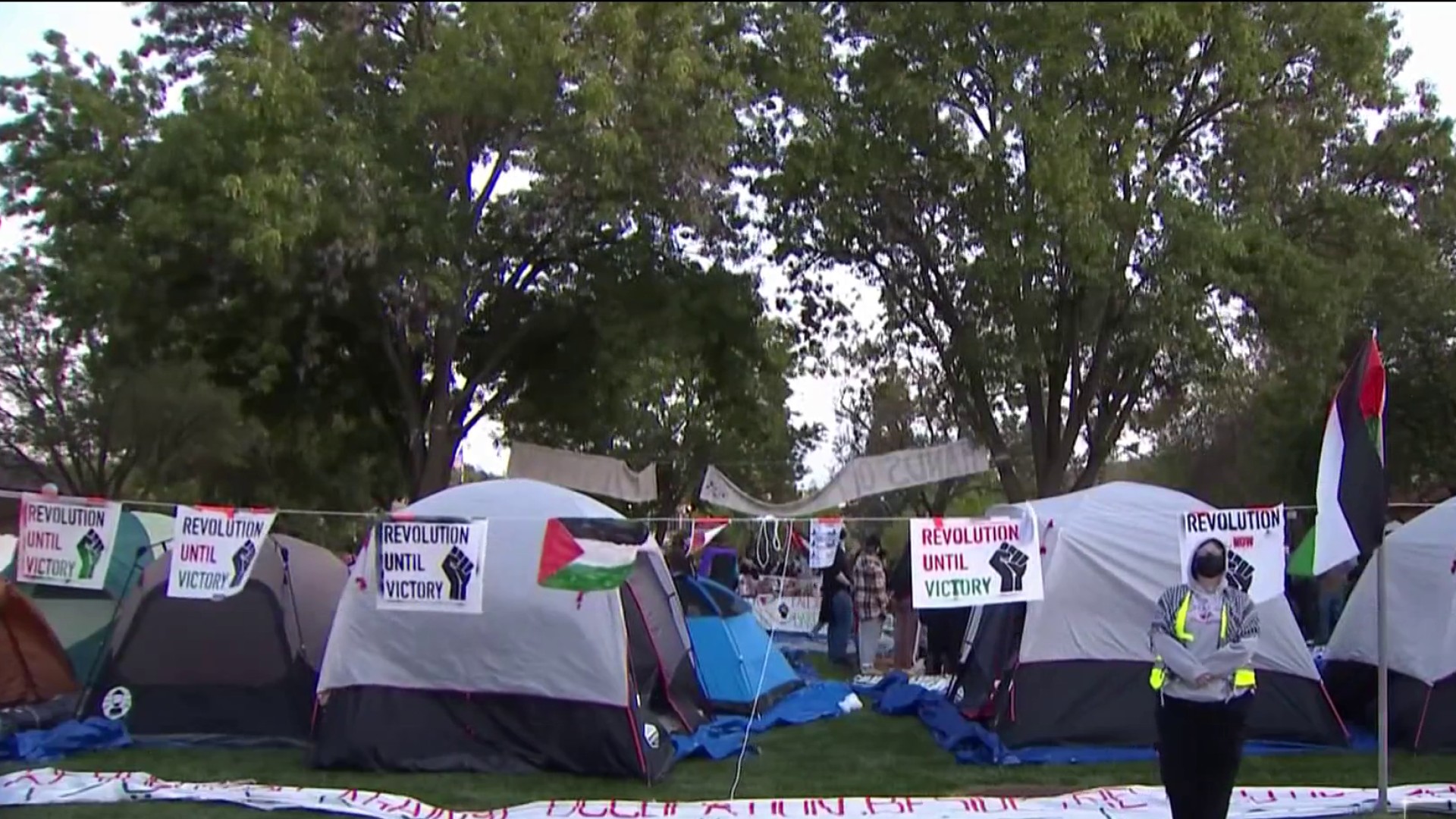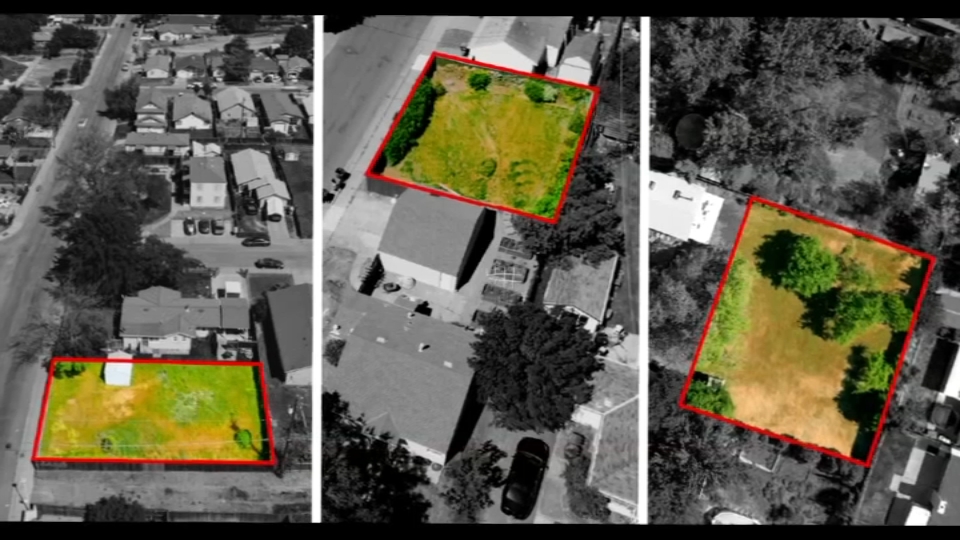It was a foggy Saturday morning atop San Francisco's Nob Hill, and a small group was gathered by the fountain in Huntington Park, listening to Bruce Bennett tell a story that began in 1873.
"Andrew Smith Hallidie descended down into the fog," he started. "They all raised a hand to their ear, to listen for the catastrophic crash — which never came."
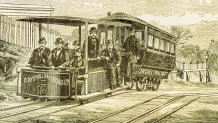
Bennett is a volunteer tour guide with the nonprofit San Francisco City Guides, and his newest tour begins with the story of the very first cable car ride, which took place on San Francisco's Clay Street 150 years ago. It's the story of how an endless loop of wire rope — running at 9.5 miles per hour in a slot beneath the street — shaped the neighborhoods and the history of San Francisco.
Get a weekly recap of the latest San Francisco Bay Area housing news. Sign up for NBC Bay Area’s Housing Deconstructed newsletter.
"That's what got the upper class people to move to Nob Hill," Bennett explained. "So it made our hills accessible."
In the early months of 2023, Bennett realized that out of more than 70 different free walking tours, San Francisco City Guides didn't have one about the cable cars. So he decided to create one. And by what he describes as sheer luck, his timing was absolutely perfect.
"I didn't know it was the 150th anniversary," he confessed. "It just happened to work out that way."
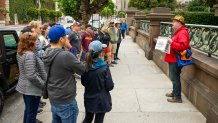
In fact, Bennett's new walking tour launched just as the city embarked on a yearlong string of celebrations honoring the 150th anniversary of Andrew Smith Hallidie's very first cable car ride. At an event in June, organized by the transit history preservation nonprofit Market Street Railway, elected officials joined actors in period costume from the 1880s at the Market Street terminal of the California Street cable car line.
Local
"How many of you were alive 150 years ago?" San Francisco Mayor London Breed asked the crowd.
By all accounts, no hands should have gone up, but San Francisco does love a good costume party — and it turned out one of the people in period garb was none other than a present-day incarnation of Andrew Smith Hallidie.
"I'm told I look very good for being dead 123 years," he said, while remaining perfectly in character.
Colorful celebrations against a dark backdrop
Politicians love to open with a joke, but Mayor Breed had some business to discuss. About a week earlier, the public had learned of the latest chapter in the unraveling of San Francisco's downtown: A major department store, a movie theater and an upscale shopping mall were all calling it quits, leaving even fewer reasons to visit the once-thriving neighborhood around Union Square. Headlines that spoke of the now-infamous "urban doom loop" narrative were everywhere.
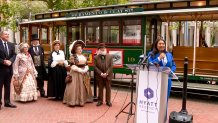
"While other people are trying to write us off, we are doubling down," by leaning into what makes San Francisco special, Mayor Breed told the crowd. "When they come to San Francisco to visit, they want to go to the Golden Gate Bridge, and they want to ride a cable car."
Bruce Bennett said he also wants to show people a different side of San Francisco than they've seen in recent headlines.
"I think, 'What is it that I can do to promote San Francisco in a positive light?'" he said. "And my way of doing that is through giving this tour."
As they waited in line to board the cable cars at Fisherman's Wharf, visitors to the city had no complaints.
"We've been here a day and a half, and it's just been incredible," said one man from Iowa.
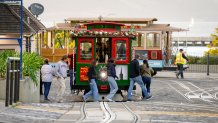
As cable cars coasted down the hill onto the turntable, where transit operators spin them around and push them back out onto the tracks using their own body weight, visiting families snapped photos of each other hanging off the sides of the cable cars and sitting on their wooden seats, marveling at just how old they are.
"It's such a crazy old technology that we still use today," remarked Nick Schuster, who was visiting with his whole family from Colorado.
"It reminds me of my youth, listening to the Rice-A-Roni commercials," said a woman named Stephanie from Indiana, and added that she'd enjoyed riding a the cable car across the city once already. "It's the San Francisco treat!"
And over on California Street, an extra special treat was in store after the mayor finished speaking: the official unveiling of the city's oldest and largest cable car, fully restored and ready for service. Built in 1883, "Big 19" is four feet longer than any other cable car in the city, and had to be specially modified to make the tight turn onto California Street without getting stuck. At its unveiling, Big 19 coasted through a polka-dotted ribbon, and was met with cheers and applause.
"It looks as good today as it did then, and I want to thank all those workers who've continued to preserve it," said the reanimated Andrew Smith Hallidie, who was very much alive when Big 19 went into service the first time.
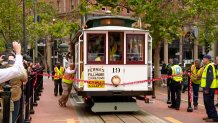
Building a legacy out of wood
Preserving history this old requires far more than just cleaning and maintenance. As the companies all over the region that built and serviced cable cars slowly vanished over the course of the 20th century, an entire craft could've been lost to time — but instead, it lives on at a small building in San Francisco's Dogpatch neighborhood: the Muni carpenter shop. It's the last place on earth you can get parts for a cable car. And they build them all from scratch.
"This here is a cable car gong," explained shop supervisor Andrew McCarron, using the technical name for the large brass bell on the cable car's roof.
McCarron spoke to a small group of devoted rail transit enthusiasts attending a rare public tour of the shop, held in honor of the cable car's 150th anniversary. He showed off the mold used to cast new cable car bells, complete with an embossed Muni logo. Behind him, a half-built cable car had just had its brand new seats freshly sanded by two carpenters who are rebuilding it piece by piece, working from 50-year-old copies of 100-year-old plans.
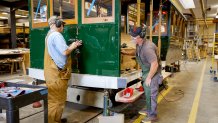
"If you like to work with wood, this is the place," said carpenter Luis Ferreira with a good-natured chuckle.
Ferreira had just finished rebuilding the roof of Powell Street cable car No. 18 with perfectly-aligned strips of yellow Alaskan cedar, supported by curved beams of California white oak. Car 18 was the first cable car Muni rebuilt entirely in-house back in the 1960s, and it included some regrettable errors — like a plywood roof that eventually leaked. Ferreira said he was excited to rebuild it the old way.
"It's similar to a wine barrel," he said, making a round gesture with his hands. "It slopes this way, and it slopes this way."
Cable car No. 18 will also be the first rebuilt car to feature two-tone wood with mahogany windows — something was specified in the original plans, but never implemented until now. Mahogany is rot-resistant, and well suited to San Francisco's foggy and sometimes rainy weather. Ferreira gazed up at the finished roof and windows he'd spent so many hours on — fully assembled, with no paint or sealant on them yet.
"The natural wood — it cannot get prettier than this!" he said.
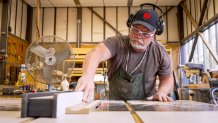
Across the room, carpenter Mark Sobichevsky was carefully adjusting a table saw to remove a tiny sliver of wood from a piece of trim — the final touch for car No. 18's new seats. Sobichevsky built high-end homes during the dot-com boom, but now he's building a legacy: This will be the tenth cable car he's worked on from start to finish. Asked what he loves about his work, he doesn't hesitate to answer.
"Seeing what I built," he said. "Seeing people happy on the line — kids, tourists."
Though Bay Area families continue to enjoy the homes he's built up and down the San Francisco peninsula, millions of people from all over the world enjoy the cable cars every year — and Sobichevsky gets to share in that joy.
"When I retire, if I retire, I will be going down on the line, to the turnaround, and look at the things I've built," he said, and added that it's already a place he likes to bring his 7-year-old granddaughter.
Asked if his granddaughter understands how much love he's put into these rolling pieces of history, he replied, "I hope so. I hope so. It's my life."
Saving the cable cars
But for all the men who've built and restored them, it's women who've saved the cable cars from political annihilation — over and over again. First, there was Friedel Klussmann, known to history as the Cable Car Lady. In the 1940s, and again in the 1950s, she organized ballot measure campaigns to protect the cable cars when politicians wanted to replace them with buses and trolleys.
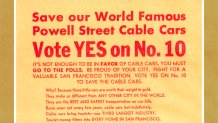
And then there was Mayor Dianne Feinstein, who raised $60 million from corporate donors to fully overhaul the aging cable car system in time for a 1984 reopening.
But it wasn't until the 1990s that a woman finally shattered the glass ceiling at Muni's cable car division. At the age of 52, Fannie Mae Barnes became the first woman ever promoted into the front operator's position on the cable car: the incredibly physical job commonly known as the "gripman."
In a ceremony 150 years to the day after Andrew Smith Hallidie's historic ride, it was only fitting that the first woman ever to operate the cable car grip levers received recognition from the first woman ever to be Speaker of the House. Barnes posed for pictures with U.S. Rep. Nancy Pelosi and Mayor Breed, and told the crowd she was just doing what her mom told her.
"My mom told me, 'Baby, you can do whatever you want to, you just have to put in the work,' and that's exactly what I did!" Barnes said to cheers and applause.
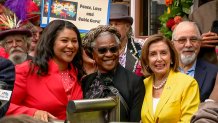
Saying goodbye
But as the flagship Powell Cable Car No. 1 pulled away from the Market Street turnaround adorned in fresh flowers, there was someone missing. The former mayor, now U.S. Senator Dianne Feinstein, had gotten sick. She died just two months later, at the age of 90. Her death came all too soon after the loss of another San Francisco icon who loved the cable cars: legendary singer Tony Bennett.
Upon news of his passing in July, fans flocked to the Fairmont Hotel, where a statue of Bennett stands tall and proud on the front lawn. They left cards and flowers, and shared fond memories.
"He represents the good side of San Francisco — the cable cars, the fog," said one woman.
"In spite of all the problems everybody says we have, people who live here love San Francisco — and he loved it," said another.
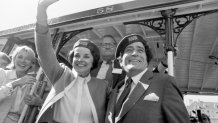
Bennett immortalized an idyllic image of the City by the Bay in his greatest hit of all time, "I Left My Heart in San Francisco." The lyrics paint an image of steep hills shrouded in fog, "where little cable cars climb halfway to the stars."
The statue of Bennett, at the hotel where he first performed the song in 1961, sits at the very top of Nob Hill — which is also the highest elevation reached by any cable car line. Standing in front of the statue, Bruce Bennett — no relation to Tony — confirmed that it's true: "It doesn't get any higher than this for the cable cars, so we are, essentially, halfway to the stars."
In fact, he decided to name his new walking tour "Cable Cars: Halfway to the Stars" in memory of Bennett. He's in good company: Mayor Breed has also said she wants to name a cable car after Tony Bennett.
San Francisco is a city of ups and downs — and not just the hills. Long before the boom and bust economies of tech and real estate, it was devastating fires that forced the city to start over from nothing again and again — and it's why the city's flag bears the emblem of the phoenix. But Board of Supervisors president Aaron Peskin thinks there's another symbol of San Francisco's ability to rise from its ashes.
"The city burned down to the ground three times, and the cable car was a constant through all of that," he said. "I suggest that the real symbol of resilience is our cable car."

